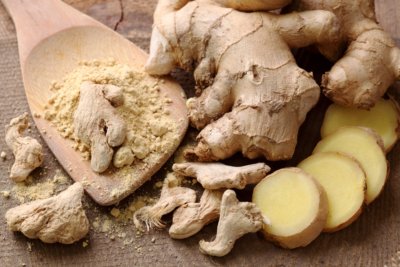
iStock.com/egal
Ginger for migraine relief…is it possible? Research says it is, so let’s take a closer look at what this could mean for migraine sufferers.
Treating Migraine Pain with Drugs
You wake up, and it hits you.
That sharp and severe, pounding pain located at one side of your head.
It doesn’t matter which side, because it basically takes you hostage. And you’re just looking to escape your migraine headache by any means necessary…
Migraines only account for six percent of headaches. However, what they lack in numbers they certainly make up for in severity.
Often that method of getting your freedom back is an ultra-strength “Tylenol.” Better known in the medical world as the highest dose of the painkiller acetaminophen. It is one of the most common over-the-counter (OTC) pain relievers. These non-steroidal anti-inflammatory drugs (NSAIDs) are designed to relieve pain and decrease inflammation.
However, OTC painkillers are quite limited in cases of severe migraines. This is where you would turn to the most popular prescription migraine drugs known as triptans.
They work by blocking pain pathways in the brain and constricting blood vessels.
The gold standard among triptans is considered to be sumatriptan (“Imitrex”), since it is the most studied and has the longest track record.
But, there is good news and bad news with sumatriptan. The good news is that it brings almost immediate relief. The bad news is that the migraines come back in an estimated 40% of patients within 24 hours. On top of that, minor side effects include dizziness, drowsiness, nausea, muscle weakness, and tightness in the chest or throat. On the more serious side, this drug could also cause heart attack, stroke, coronary artery spasm, seizure, and even abnormal heartbeat.
Ginger for Migraine Pain
What if I told you that an item in your kitchen’s spice rack may be just as good as sumatriptan for migraines? And, it’s so much safer.
I’m talking about ginger. Let’s take a look at the research on this. In a 2014 double-blind study, neurologists compared dried ginger powder and sumatriptan in 100 women and men suffering from migraines for an average of seven years.
After being randomly assigned to a group, each person was given either daily amounts of 250 milligrams (mg) of ginger or 50 mg of sumatriptan for a month. The participants recorded headache severity before, as well as 24 hours after, taking a dose.
Compared head-to-head, ginger powder showed equal effectiveness. And there was a far greater safety profile. Both ginger and sumatriptan achieved 90% relief in patients within two hours of ingestion.
Ninety percent!
At the same time, four percent of those taking ginger experienced minor digestive effects, while 20% of the sumatriptan group reported heartburn, drowsiness, or dizziness.
Ginger for Migraine: Dosage
Something else to consider with the strength of ginger is the dosage. The study’s 250 mg of ginger daily was considerably low. Higher doses of ginger would likely have produced far better results. Ginger may have even outperformed sumatriptan. Interestingly, most clinical studies use higher doses of one gram of powder ginger daily.
Ginger as a General Pain Reliever
Ginger’s ability to relieve pain and reduce inflammation is well documented. Some clinical studies have found ginger to be effective for muscle pain, chronic low back pain, arthritis, and painful menstruation. Other research also supports ginger extract for migraines, but mostly when combined with feverfew (another herbal migraine remedy).
Why is ginger such as an excellent painkiller? It is likely due to its active compounds, like gingerol.
How to Use Ginger for Migraine Pain
You can use powdered ginger, but I recommend using a quarter-inch of freshly sliced ginger each day. Try juicing fresh ginger and combining it with your favorite vegetables and fruit. If you don’t have a juicer, you can also add grated fresh ginger to your water or smoothie. Or, make it into tea to reduce inflammation daily.
You can find fresh ginger root in the produce section of most grocery stores. Look for fresh ginger without any signs of decay, such as dry, wrinkled skin; mildew; or soft spots. Ginger also stores quite nicely in the refrigerator.
Keep ginger in mind whenever you feel a migraine coming on, rather than having your trigger finger on that OTC or prescription drug.
Related Articles:
Sources
Murray, M., “Ginger as Effective as Synthetic Drug in Migraine, but Without the Side Effects,” GreenMedinfo, July 17, 2017; http://www.greenmedinfo.com/blog/ginger-effective-synthetic-drug-migraine-without-side-effects, last accessed August 9, 2017.
Maghbooli, M., et al., “Comparison between the efficacy of ginger and sumatriptan in the ablative treatment of the common migraine,” Phytotherapy Research, May 9, 2014; 28(3): 412-415, doi: 10.1002/ptr.4996.
Balch, J., et al., Prescription for Natural Cures: A Self-Care Guide for Treating Health Problems with Natural Remedies Including Diet, Nutrition, Supplements, and Other Holistic Methods (Hoboken: John Wiley & Sons, Inc., 2004), 350-355.
“Migraine Drugs,” Healthline, March 28, 2016; http://www.healthline.com/health/migraine-drugs#overview1, last accessed August 9, 2017.
“Sumatriptan, Oral Tablet,” Healthline, Feb. 17, 2017; http://www.healthline.com/health/sumatriptan-oral-tablet#highlights1, last accessed August 9, 2017.
